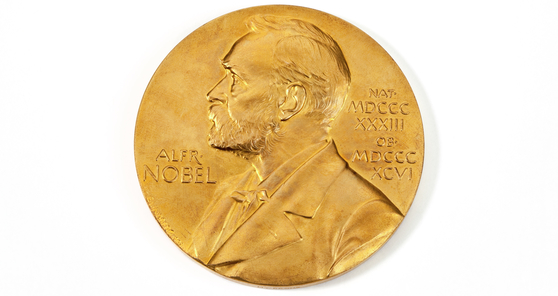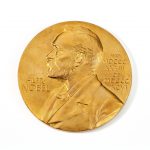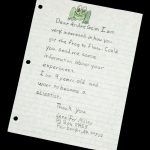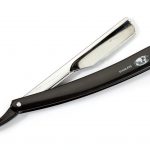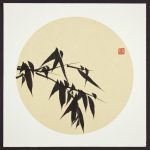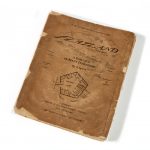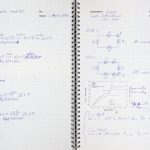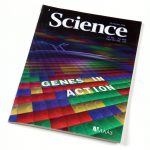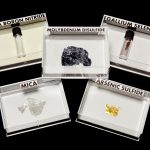From 2D to 3D: the story of graphene in objects
Article DOI: https://dx.doi.org/10.15180/181004
Abstract
First isolated using sticky tape in Manchester in 2004, graphene is a nanoscience breakthrough which has captured the imagination of the press and the scientific community. Despite the obvious hook of the isolation story, nanoscience is a challenging topic to present in a museum exhibition. The Wonder Materials exhibition answered this challenge by introducing objects which would be familiar and relatable to visitors. This paper examines this approach using ten case-study objects featured in the exhibition to illustrate discussion of representation of the material culture of contemporary science in museum exhibitions, and to examine some of the curatorial methods used by the content team to make an intangible nanomaterial feel more real for visitors.
Keywords
contemporary collecting, contemporary science, Graphene, material culture, museum exhibitions
Introduction
https://dx.doi.org/10.15180/Science stories and objects have traditionally been displayed as part of the distant past: heroic, historic, complete. This approach has sometimes led to a perception by museum audiences that science is closed and finished, when in fact science is inherently dynamic and ongoing. To shift the emphasis from static to dynamic in museum science collections and displays, museums increasingly engage in contemporary collecting. Museum professionals actively engage with scientists to identify physical objects for accession into permanent museum collections. The way in which the material culture of science is curated in museum collections and exhibitions has a role in creating and reinforcing the historical narratives of science and scientists.
While it is increasingly considered to be essential, contemporary collecting in the field of science presents challenges. Material culture in contemporary science often involves objects which are expensive and unwieldy, making them difficult to acquire, store and display. While the equipment can be large and difficult to move and display, for example the pieces of the Large Hadron Collider displayed in the Collider exhibition (Science Museum, 2013), the science itself often takes place on the nanoscale, on the level of atoms and even smaller. Scientific equipment tends to be extremely specialised, making it challenging for non-specialist museum professionals to interpret and for visitors to engage with. Whereas historical scientific instruments are often inherently attractive to look at, made of brass and wood, their function apparent, contemporary scientific instruments are often effectively a ‘black box’, their function not easily apparent. A further challenge is that while the material culture of science includes obscure and specialised scientific equipment, it can also include objects which are problematically mundane and perhaps even over-familiar and hence under-whelming to visitors, as I will discuss later. Finally, all contemporary collecting is inherently resource intensive for museums, requiring considerable staff time for research and relationship building.
These are challenges that museums must address. This paper presents an example of the strategic curatorial thinking behind a contemporary science exhibition, as well as exploring the specific challenges entailed in presenting one of the most recent and startling discoveries in contemporary science: the discovery of graphene, a new material with several extraordinary properties. The touring exhibition Wonder Materials: Graphene and Beyond, developed in 2016 at the Museum of Science and Industry, Manchester, tells the story of graphene through objects.
Graphene was first isolated at the University of Manchester in 2003 by a team led by Andre Geim and Kostya Novoselov (Novoselov et al, 2004). It was the first 2D material ever discovered and intrigued the scientific community and world media with its many superlative properties and potential applications. By the time the Wonder Materials exhibition opened in Manchester in 2016, graphene had been in the media for over a decade, much-vaunted and sometimes perceived as under-achieving against initial expectations. As a Manchester-based, national museum with large visitor numbers, the Museum of Science and Industry was the appropriate place to take a look at graphene over a decade on and re-present an authentic and engaging graphene story for our visitors, emphasising the fact that graphene is still in its very early stages.
Developing this exhibition was of strategic benefit to the Museum, providing it with an opportunity to grow its independent adult audience, showcase Manchester science and explore the potential global impact of graphene. Wonder Materials: Graphene and Beyond ran at the Museum of Science and Industry from 22 July 2016–21 June 2017, will tour internationally until 2021, and was the first exhibition developed at the Museum of Science and Industry for international tour.
Graphene’s list of properties – most conductive, strongest, thinnest, as well as stretchy and flexible – caught the imagination of scientists all over the world, and inspired an explosion of research interest (Larousserie, 2013). As well as having potential for technological application from water desalination to flexible electronics, graphene excited researchers by revealing secrets of fundamental physics. Graphene ‘provides a cornucopia of new physics… It’s like the Large Hadron Collider, but on your desktop’ (Geim, 2008).
Developing an exhibition about graphene presented curatorial challenges. Graphene science is difficult, and it is invisible to the human eye. The exhibition team had to think creatively to overcome these challenges. Several factors helped here: the project was supported by the staff at the National Graphene Institute at the University of Manchester, there were opportunities to visit the labs where graphene was first isolated, and the team were in communication with the scientists responsible for isolating graphene.
As a method for exploring how the process of science is displayed using objects, this paper will examine ten objects featured in the Wonder Materials exhibition. I will analyse the rationale for inclusion and how they were understood to support and indeed create the narrative of the exhibition. I will show how each of the objects plays a role in emphasising the importance of creativity in science, and transparency in the way science is presented to museum audiences. I will unpick how and why we chose to use personal stories and objects as a hook to engage visitors with the otherwise potentially abstract and specialist graphene story.
The objects I focus on range from an unassuming sticky tape dispenser to the replica Nobel medals of the leading scientists; from a cut-throat razor to some fan mail from a little girl in Alaska. This paper is supported by quotes from Andre Geim and Kostya Novoselov, both of whom assisted the exhibition curators (Danielle Olsen and Sarah Baines) in developing ideas on the material culture of graphene for inclusion in Wonder Materials. Several of the objects provoke elucidation of the challenges of representing an ongoing, unfolding ‘live’ story in an exhibition and the museum collection, with the scientists involved. The contrast between some of the objects leads to discussion of the issue of authenticity of contemporary science objects; some are inherently personal artefacts, specific and unique, while others are included for the very reason that they are mass-produced.
Selecting ‘origin story’ objects
https://dx.doi.org/10.15180/181004/002The isolation of graphene was a headline science story of the new millennium, and since the initial research was published in 2004 (Novoselov et al, 2004), the new material has been subjected to a great deal of media attention, with important related products presented as imminent. When these expectations were not realised, there was a perception that graphene had failed to live up to expectations (Colapinto, 2014). The Wonder Materials content team were wary of contributing to the unrealistic expectations heaped on graphene. The aim of Wonder Materials was to go beyond product-focused expectation and subsequent narratives of perceived disappointment and instead focus on the inspiration and wonder that comes with an exciting new area of scientific exploration. The content team were inspired by the curiosity and playfulness in Geim and Novoselov’s scientific approach and decided that this would set the tone for presentation and interpretation of graphene in the exhibition. This approach resonated with our intention to follow the recent cultural ‘shift in focus from science as a finished product to science as a continuous process – science in the making’ (Filippoupoliti, 2010, p 21).
No object in the exhibition captures Geim and Novoselov’s approach better than an ordinary sticky tape dispenser. We made this the first object visitors encountered on entering the exhibition, displayed alongside two replica Nobel medals. The contrast between these items creates provocative dissonance. The juxtaposition of these objects – one cheap, mass produced and mundane, the others gold-plated and a famous mark of the highest level of achievement – is intended to spark curiosity. The placement of the sticky tape dispenser alongside these famous symbols of recognition and achievement visually illustrates the extraordinary origin story of graphene. When developing the content for Wonder Materials, we were wary of falling back on a traditional hagiographic narrative. Instead we decided to display these objects together to introduce the story of how a curious, playful approach led to the highest honour in science.
Sticky tape dispenser
https://dx.doi.org/10.15180/181004/003Graphene was first isolated using ordinary sticky tape, a surprising fact that made the graphene origin story particularly appealing to science journalists and the scientific community alike. Scientists already knew about the theoretical existence of materials comprising single atomic layers but no-one had previously been able to isolate a single layer. Scientists since 1859 had been trying to achieve this using chemical and mechanical exfoliation methods involving expensive and specialised equipment (Brodie, 1859). However, when a single sheet of graphene was finally isolated, it was done using a cheap and familiar piece of equipment.

The story of how graphene was first isolated using sticky tape was recounted by Andre Geim in his Nobel Lecture (Geim, 2010). He explained that while working on the graphene problem, Oleg Shklyarevskii, a senior fellow from Kharkov, Ukraine,
…Interjected by bringing over a piece of cellotape [sic] with graphite flakes attached to it. Allegedly, he just fished out the tape from a litter bin […] a fresh surface of graphite is normally prepared by removing a top layer with sticky tape. We used this technique for years but never looked carefully at what was thrown away along with the tape. I looked in the microscope at the remnants of graphite and found pieces much thinner [than had been achieved by other methods]
A mass-produced and unremarkable object more familiar in an office than in a science laboratory, this particular tape dispenser is nonetheless special because it was the actual dispenser used in the discovery of graphene and hence forms part of an extraordinary story. The dispenser was donated to the Museum of Science and Industry by Novoselov in 2006 as part of a contemporary collecting project inspired by the isolation of graphene in Manchester. This object is a prime example of the sort of everyday equipment that is part of a science story, but often lost over time precisely because it is so mundane. Ordinary though it is, visitors can recognise and engage with this object and it provides a quirky, attention-grabbing gateway into the graphene story.
Nobel Prize replicas
https://dx.doi.org/10.15180/181004/004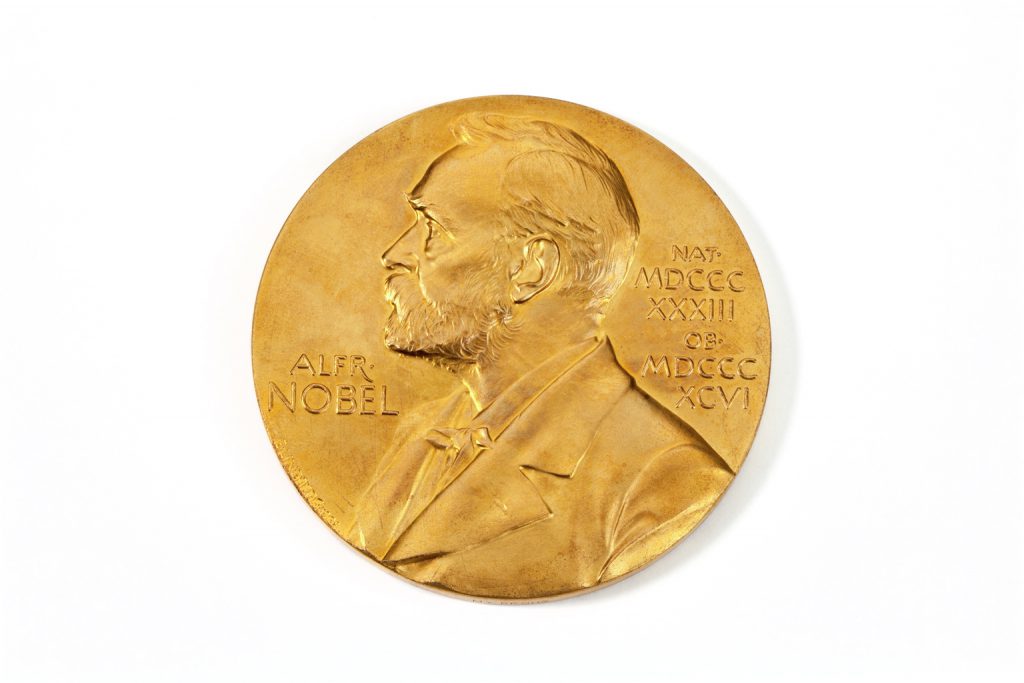
The next key ingredient in the graphene origin story is the Nobel Prize. The 2010 Nobel Prize in Physics was awarded jointly to Andre Geim and Konstantin Novoselov ‘for ground breaking experiments regarding the two-dimensional material graphene’ (Nobelprize.org, 2010). Although their approach to isolating graphene was playful, there is no award taken more seriously than the Nobel Prize. As a direct result of the relationship developed with Geim and Novoselov, the Museum was able to borrow their personal Nobel medal replicas. We know that visitors greatly appreciate seeing the ‘real thing’. Nobel medals are widely recognisable both physically and conceptually, and the fact that these are the personal replicas of the prize winners, displayed alongside reproduced photos of them proudly accepting their prizes makes the display feel more personal and engaging.
Evaluation on the exhibition completed by the Science Museum Group Visitor Insight team reported that ‘In terms of visitors’ favourite parts of the exhibition, a lot of the content and layout came in for praise, including the story of the Nobel Prize winners, the recreation of the lab with the “real-life” touches, and even the roll of sticky tape’ (SMG document, Tim Neal, Visitor Insight Manager, 4 April 2017). The fact that the Nobel Prize winners and the role of sticky tape were two of the three favourite parts of the exhibition for visitors suggests that leading with these objects was impactful for visitors and played a role in engaging them with the story of graphene.
Representing scientific approach using objects
https://dx.doi.org/10.15180/181004/005By asking: ‘How effective is the exhibition as a means of communicating current research to the public?’, Anastasia Filippoupoliti (2010, p 12) problematises the very notion that we can communicate science knowledge in an exhibition. According to Museum of Science and Industry audience research, the average dwell time in the Wonder Materials exhibition was 23 minutes. In that short space of time it is unlikely that someone will concentrate and commit to attempting to grasp difficult scientific theory they may not have encountered before. Instead, we aimed to stimulate interested and curiosity by putting the emphasis on personal stories, using objects which would resonate with visitors and give them a reason to care about the story of graphene.
The next three objects this paper discusses are not science objects. They were included in the exhibition because they provide insight into the personality of the scientists. Looking carefully at these objects exposes a surprising non-scientific aspect to the material culture of contemporary science – the significance of context, approach and personality. Museum professionals know that visitors respond to ‘people stories’ in exhibitions as they increase our ability to identify with the makers or users of objects. Personal stories help us to understand science as an accessible human endeavour rather than an isolated profession done behind closed doors. One of the strengths of working with contemporary science is that the scientists are available for museum professionals to engage with, and the personal stories can be represented using objects which make the scientists feel very present in the display. A recent example of this approach at the Science Museum was the acquisition of objects relating to the discovery of the Higgs boson particle. Like graphene, this was an area of physics very challenging to represent in objects for a museum collection or exhibition. The equipment at CERN is huge and unavailable, while the physics itself is nanoscale and intangible. To represent the story, curators at the Science Museum acquired, amongst other things, the champagne bottle emptied by Professor Peter Higgs and colleagues on the evening of 3 July 2012, in a celebration prior to CERN’s announcement the next day regarding the discovery of a particle consistent with the Higgs boson.
Science Museum Group exhibitions have used personal, everyday objects as a method for making contemporary science exhibitions engaging and immersive for visitors. Writing about the experience of curating the Collider exhibition, Alison Boyle and Harry Cliff explain that recreations of scientists’ offices allowed the curators of the Collider exhibition to provide ‘a rich and light-hearted portrait of daily life at CERN, including conference posters, in-jokes, bus schedules, adverts for the table tennis club and personal effects like an abandoned pair of shoes and a cardigan’ (Boyle and Cliff, 2014). Boyle goes on to quote Jordanova, ‘It is the responsibility of science museums to explain how science comes about’ (Jordanova, 2014); showing the reality of day-to-day work can help to temper heroic representations of science and scientists.
At the heart of the graphene story were two scientists with an interesting story, potentially providing a hook for engaging visitors. In The Rise, Sarah Lewis (2014) characterises Geim and Novoselov as ‘Deliberate Amateurs’. She remarks on the passion and sense of adventure they demonstrate in the way they use their knowledge and expertise to explore unfamiliar fields. In Geim’s opinion, ‘The biggest adventure is to move into an area in which you are not an expert’. He explains in his Nobel Lecture that he didn’t want to get stuck in one field for his whole scientific career, losing inspiration and getting stale: ‘Sometimes I joke that I am not interested in doing re-search, only search’ (Lewis, 2014, p 147). He goes even further, stating that it is ‘Better to be wrong than boring’ (Geim, 2010, p 76).
In the 1990s whilst at the University of Nijmegen in the Netherlands, Geim began conducting what came to be known as his ‘Friday Night Experiments’ where his team investigated unfamiliar areas of science. He felt that they were entering relatively unknown territory, questioning things people who work in that field have stopped bothering to ask:
I jump from one research subject to another every few years. I do not want to study the same stuff ‘from cradle to coffin’, as some academics do. To be able to do this, we often carry out what I call ‘hit-and-run experiments’. Some crazy ideas that should never work and, of course, they don’t in most cases. However, sometimes we find a pearl. This research style may sound appealing but it is very hard psychologically, mentally, physically, and in terms of research grants too. But it is fun.
One of the first successes to come out of the Friday Night Experiments was when Geim demonstrated diamagnetic force by levitating a live frog in a very powerful electromagnet. Following publication of this funny yet genuinely scientifically interesting experiment (Berry and Geim, 1997), he was awarded a coveted IgNobel Prize from Improbable Research for research that ‘makes people laugh and then makes them think’ (Improbable Research, 2010). Geim is the only person to have won both an IgNobel Prize and the Nobel Prize, and stated that he is ‘actually quite proud’ of his IgNobel Prize (Improbable Research, 2010).
A letter from Alaska
https://dx.doi.org/10.15180/181004/006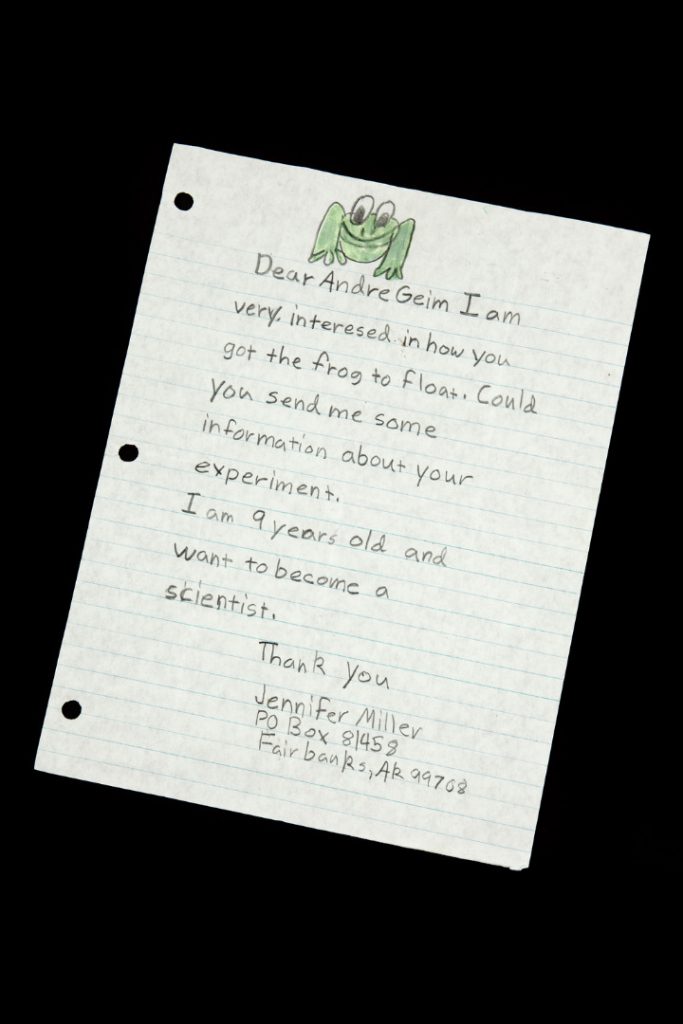
The fact that this research inspired people it is clear to see in a handwritten letter sent to Andre by Jennifer, a little girl from Alaska. She writes: ‘Dear Andre Geim, I am very interested in how you got the frog to float. Could you send me some information about your experiments. I am 9 years old and want to become a scientist. Thank you.’ Andre kept this letter, proud that his research had been so inspiring. This letter is another example of the objects which can be unearthed as a result of developing a relationship with some of the key individuals featured in an exhibition. This letter was mentioned to one of the curators during a conversation with Geim. This example demonstrates the curatorial expertise in searching for and selecting material culture which may be tangential to the central story – in this case the isolation of graphene – yet illuminates a certain aspect of the story, making it easier for visitors to engage with the exhibition content.
Kostya’s razor
https://dx.doi.org/10.15180/181004/007
This razor is an unlikely way in to discussing the thorny issue of expertise. Although the word ‘playful’ has been used to describe Geim and Novoselov’s approach to science, Geim especially is wary of the dangerous connotations and doesn’t like to describe his approach as play. As explained by Lewis, ‘He prefers “curiosity-driven research”, “adventure”, a “Random Walk to Graphene”’ (Lewis, 2014, p 161). If these two scientists do play with science, it is in the sense that a master pianist plays the piano. ‘When a musician says that someone can play, it means they are skilled, responsive and nimble; the person knows how to harmonise or offer dissonance when it’s right’ (Lewis, 2014, p 155).
This razor represents the tacit skills often developed by technical experts – in this instance development of the physical ability to manipulate microscopic, even nano-scale, samples.[1] As a student, Novoselov bought this razor to develop steadier hands. He admits that it was ‘quite a painful and bloody experience at the beginning’ (Novoselov, 2010b), but it worked, and he has used this razor ever since. He suggests that physical, tacit skills such as this are something that each scientist must develop personally: ‘Universities teach us physics, maths, chemistry and tens of other disciplines, but each of us has to work out for himself how to do science’ [author’s italics] (Novoselov, 2010a, p 126).
Novoselov’s awareness of skill development extends to art as well as science. He is interested in Chinese painting which like creative science requires, in his words, discipline, dedication and awareness. We included in the exhibition this Chinese painting by Novoselov himself to demonstrate the influence art has had on him as a scientist.
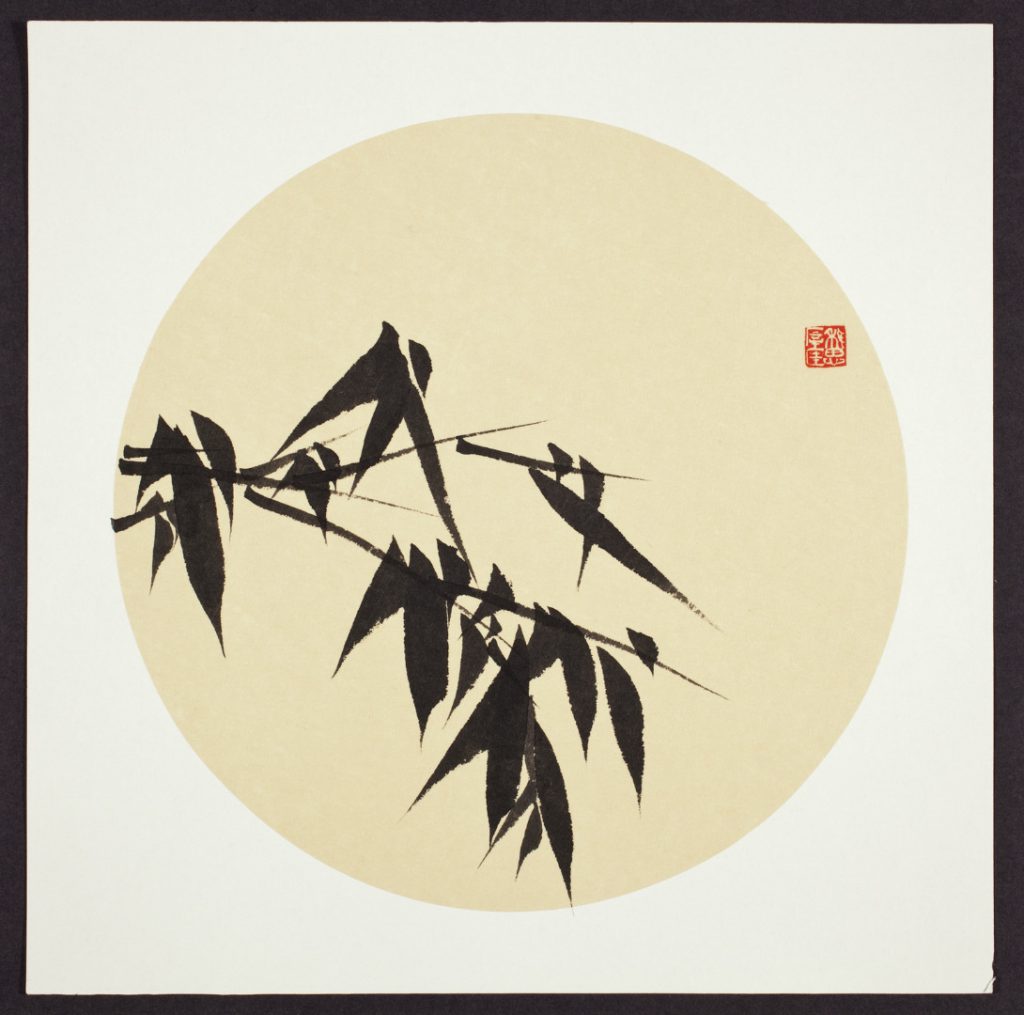
'Flatland: A Romance of Many Dimensions'
https://dx.doi.org/10.15180/181004/008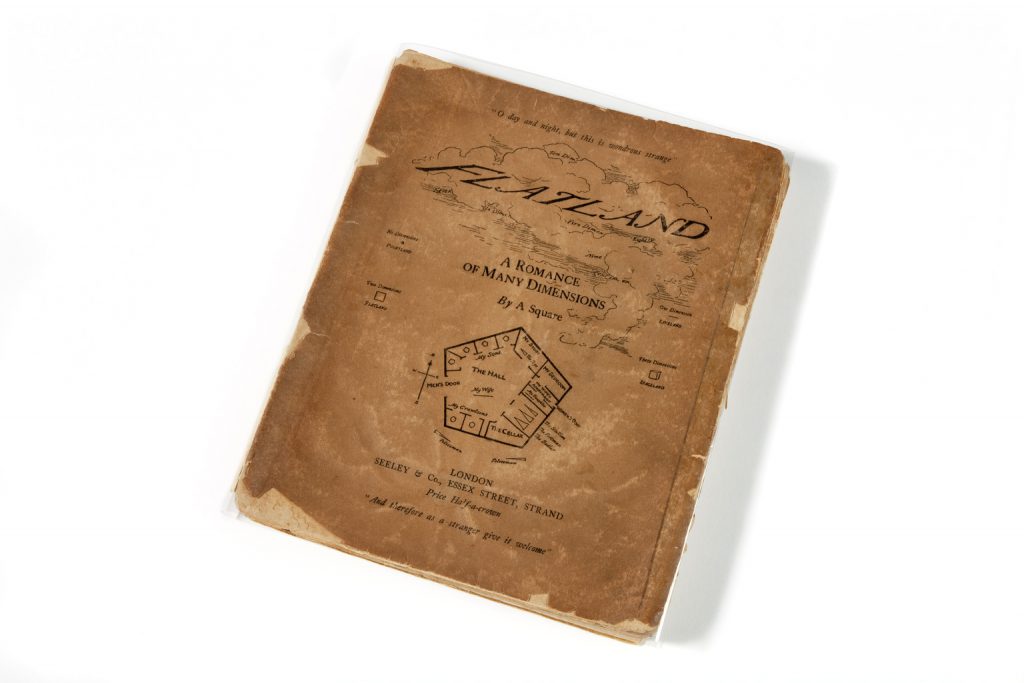
Flatland: A Romance of Many Dimensions is a satirical novel by Edwin A Abbott, written in 1884. Novoselov mentions it in his Nobel lecture: ‘Much like the world described in Abbott’s Flatland, graphene is a two-dimensional object. And, as “Flatland” is “a romance of many dimensions”, graphene is much more than just a flat crystal’ (Novoselov, 2010a, p 106). In an 1884 science-joke, Abbott wrote the novel under the pseudonym ‘A. Square’. Flatland is socially satirical and scientifically whimsical.
The inclusion of this book in the Wonder Materials exhibition introduces the idea that people have been thinking imaginatively about dimensionality for hundreds of years. As the first 2D material, graphene resonates with Abbott’s notion of ‘Flatland’, and encourages exploration of a 2D material or a 2D world. The sense in which graphene can be described as two-dimensional is due to the way the electrons behave – they move on a flat plane. Geim explains that ‘Graphene is an ultimate incarnation of the surface: It has two faces with no bulk in between’ (Geim, 2009, p 1532).
The specific book included in the Wonder Materials exhibition is Novoselov’s own first edition copy, demonstrating the fact that he takes inspiration from non-science sources, and that his science practice is informed by engagement with literature. He explains in his Nobel lecture that he has always been a keen reader, childhood favourites including Boris Pasternak, Alexander Pushkin, Jack London, H G Wells, Jerome K Jerome, Lewis Carroll and Mark Twain (Novoselov, 2010b). His Nobel lecture was titled ‘Graphene: Materials in the Flatland’ and his Nobel autobiography begins with Lewis Carroll quotes from Alice’s Adventures in Wonderland (Carroll, 1865) and Through the Looking Glass (Carroll, 1871).
Novoselov’s figurative characterisation of the world of graphene and 2D materials research as an adventure in a new flatland reinforces the key exhibition message that scientific process can be creative and playful. This message inspires wider engagement with science because it challenges the perception that science is just about maths and labs. These objects demonstrate the fact that Novoselov, a Nobel Prize-winning scientist, sees an inextricable relationship between his passions for literature and science. By including these objects in the exhibition, we encourage visitors to see imagination and science as not only related, but interdependent. We are demonstrating especially to younger visitors that choosing a career in science does not preclude engagement with other modes of engagement and expression, thereby promoting the aim of the Science Museum Group to inspire increased science engagement.
We know from the evaluation on the exhibition compiled by the Science Museum Group Visitor Insight team that visitors enjoyed seeing personal objects in the exhibition. However, another thing that came through strongly in the evaluation report was that visitors felt frustrated; they had been hoping ‘to see, or even touch graphene’ (Neal, 2017). Intangibility is one of the key challenges in exhibiting contemporary science. In the next section, I will look at some of the objects we displayed to bring out the real-life process of science – another of the methods we used to make an intangible nanomaterial feel more real for visitors.
Sharing the discovery
https://dx.doi.org/10.15180/181004/009Our measurements delivered news well beyond the Scotch tape technique, which persuaded many researchers to join in the graphene rush.
The preceding objects told stories about the personality and approach of the scientists who discovered graphene. However, at the core of the material culture of the graphene story is the physical evidence and peer-reviewed publication of research which confirmed and validated Geim and Novoselov’s initial isolation of graphene using their sticky tape method. In the UK and Europe, explains Sarah Davies, there is ‘an increasingly ingrained sense of cynicism towards – not science as such – but those who control and guide it’ (Davies, 2010, p 58). Looking carefully at the next three objects, I will argue that central to any presentation of contemporary science is transparency regarding the process by which initial experimentation leads to a legacy of respected evidence.
Novoselov lab book
https://dx.doi.org/10.15180/181004/010As a member of Andre Geim’s lab team, Kostya Novoselov was encouraged to spend about ten per cent of his time on the previously discussed Friday Night Experiments exploring topics beyond his normal research. This A4, standard, mass-produced book for recording lab work is a physical trace of the Friday Night Experiments involving the electrical properties of newly-isolated graphene, which happened in labs at the University of Manchester on the 1st and 3rd of August 2003. This book represents the research before it was published, in the hectic period where the team of scientists worked to produce results and write them up for the publication that would secure their place in history. Although most visitors won’t have the prior knowledge to understand the scientific content of these pages, this public showing of the lab book provides an insight into the real day in, day out experience of searching for evidence and gathering results. The historical significance of this book was recognised and acknowledged when it was acquired for the permanent archive at John Rylands Library in Manchester, which kindly loaned it to the Manchester Museum of Science and Industry for display in the Wonder Materials exhibition.
Graphene sample
https://dx.doi.org/10.15180/181004/011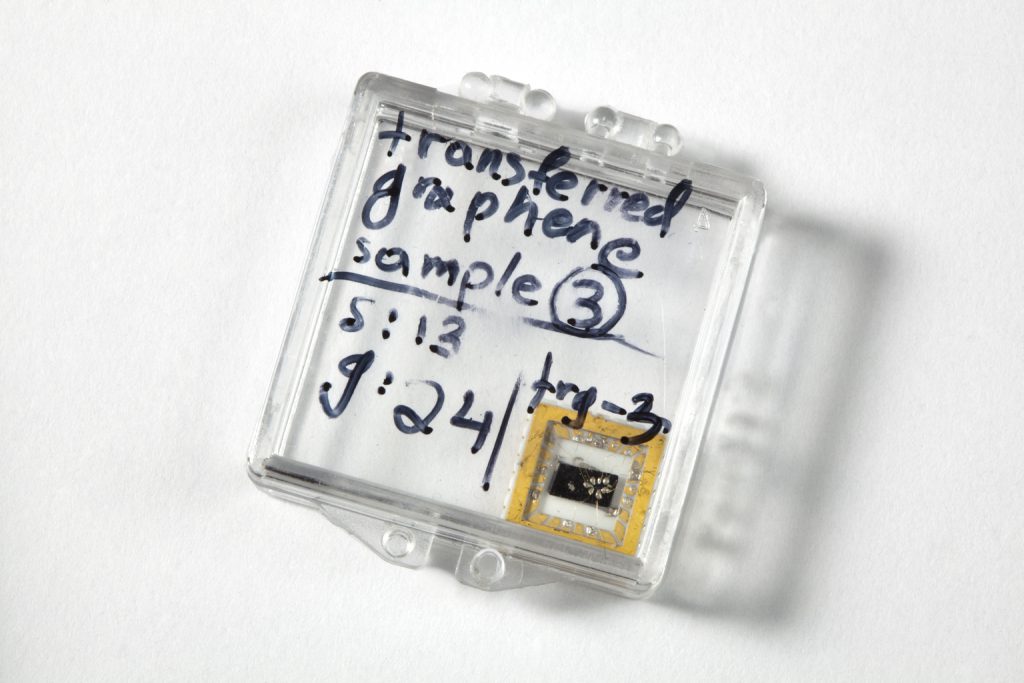
Research interest in graphene spread quickly. In 2009, Geim stated that ‘Graphene research has developed at a truly relentless pace. Several papers appear every day’ (Geim, 2009, p 1530). This is perhaps partly due to the discovery of a cheap and easy method of isolation: ‘the Scotch tape method has a low barrier to entry in that it does not require large investments or complicated equipment, which has helped considerably to broaden the geography of graphene science’ (Novoselov, 2010a, p 106). However, accepting this as the main explanation underestimates the generosity and openness with which Geim, Novoselov and their team shared their breakthrough isolation method with international colleagues. Figure 7 shows one of five graphene samples donated to the Museum of Science and Industry and accessioned into the permanent collection along with the sticky tape dispenser in 2005. Samples and experimental early graphene transistors like these helped disseminate the evidence that graphene was possible and invited scientists all over the world to test it for themselves. These samples represent a stage in the story of graphene when scientists were still working on the fundamental science rather than looking ahead (and being pestered by the press and museum curators) to possible applications for graphene. Professor Cinzia Casiraghi recalls that while she was completing her post-doctoral research on carbon nanostructures at the University of Cambridge, her group were one of the first to receive a sample like this: ‘I was actually the one who opened the box, and first saw the graphene under the microscope’ (Casiraghi, 2014). Shortly after that, in 2006, Casiraghi began collaborating directly with Geim and Novoselov. She is now Professor of Nanomaterials at the University of Manchester, based at the National Graphene Institute.
These samples demonstrate the contemporary collecting opportunities that come from collaboration between museum curators and scientists. In direct conversations, curators can encourage scientists to think more broadly about the material culture that could represent their work – and it might not be what the scientist expected. This collecting approach contrasts with historic science exhibitions, where curators often have little physical material culture associated with a discovery or an individual, and certainly very little detail about the human, experiential dimension to the story. However, as a curator developing an exhibition in collaboration with living scientists, it is important to be aware of the risk of individuals becoming too involved, and the temptation to display and/or acquire an excess of personal material and stories.
Research publication
https://dx.doi.org/10.15180/181004/012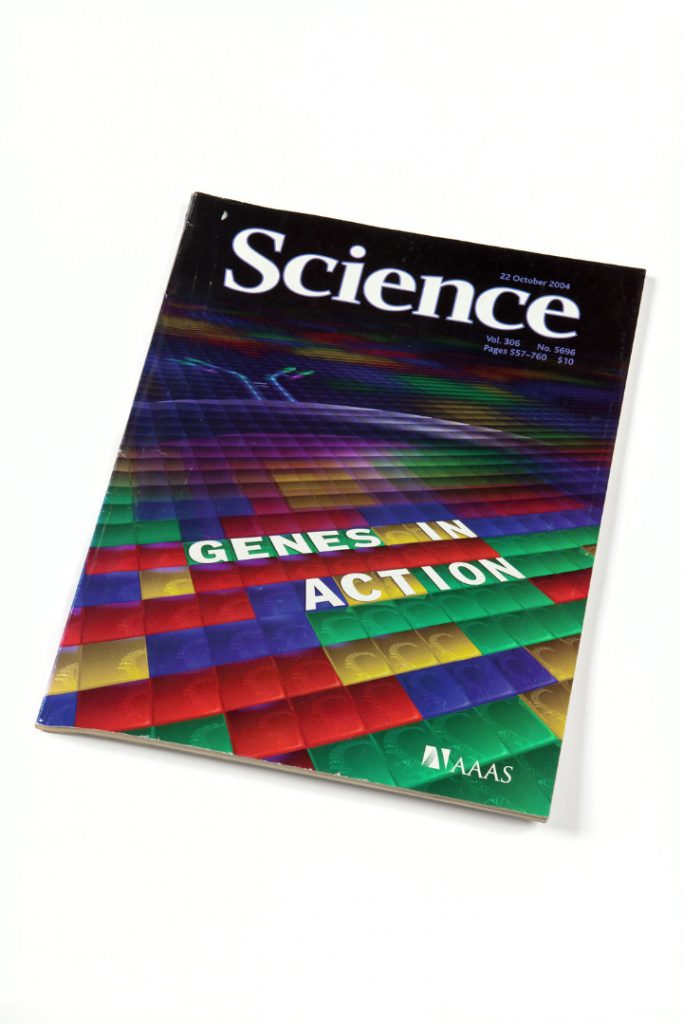
To further support the exhibition narrative that science is a process and not an end-point, we decided to include Geim’s own copy of Science in which the graphene breakthrough was first published. There is a story behind the publication of this article which demonstrates that the process of getting scientific research published in a glossy high-profile journal is intensive and laborious. When the paper was first submitted to Nature, it was rejected because according to one referee it did ‘not constitute a sufficient scientific advance’. However, eventually, after much hard work, the article was published in Science (Geim, 2010, p 84). This shows that even Nobel Prize-winning science can require much time and dedication to achieve recognition.
This paper is also interesting because along with quotes from Geim and Novoselov, it evokes the sense of excitement and urgency around the race with other scientists to prove that they had managed to isolate a single atomic layer of carbon atoms. Although graphene was not proven to have been successfully isolated before the 2004 paper, Geim explains that ‘sporadic attempts to study it can be traced back to 1859’ (Brodie, 1859, quoted in Geim, 2010, p 106). Nonetheless, the real breakthrough came when the isolation using sticky tape was first published in this peer reviewed publication when Novoselov et al detailed their observations of the electrical properties of graphene which garnered international attention and triggered what Andre calls the graphene ‘Gold Rush’: ‘Our Science paper offered the first glimpse of graphene in its new avatar as a high quality 2D electronic system and beyond’ (Geim, 2010, p 89).
The lab book, the early graphene samples, and the published research work together to demonstrate the fact that collaboration, hard work and perseverance are all essential in getting an experimental idea tested and published. While the science detail is difficult to understand, these personal qualities and approaches are something that visitors can relate to, making the science content in the exhibition more meaningful and engaging.
The legacy of the 'Wonder Materials' exhibition
https://dx.doi.org/10.15180/181004/013When scientific instruments are unique, beautiful or explanatory, they have traditionally been more likely to be valued and accessioned by museums. However, it is often the more mundane items that are lacking in museum collections. Exhibiting the material culture of graphene put us in the position of presenting ordinary, modern, mass-produced items as the science relics of the future, significant not in and of themselves, but because of who used them, why, and how. In this case, these ’ordinary’ items were selected in consultation with the scientists themselves and their part in the story confirmed and recorded. Objects like the tape dispenser, the lab book, the samples – these objects have already played their part in the graphene origin story and their significance and legacy is secured by their accession into accredited permanent museum collections.
Accessioning an object means making it legally a part of the permanent museum collection; it will be the museum’s statutory obligation to preserve and store it for future research and display on behalf of the nation. Accessioning is a solemn undertaking due to the commitment of resources implied in agreeing to preserve an object in perpetuity. Most museum collections are in storage, and curators need to consider the practical implications of the valuable resources required for the future management and care of objects.
Many of the privately-owned objects featured in the Wonder Materials exhibition and explored closely in this paper were on loan (for example, personal possessions belonging to the scientists – the Nobel medal replicas, Novoselov’s razor, the letter to Geim from Alaska). Loaned material is important in supporting and enriching museum exhibitions. However, part of the process of developing an exhibition is thinking curatorially about the legacy of the exhibition content: would any of the items exhibited or researched for the exhibition be a valuable addition to the permanent museum collection?
The sticky tape dispenser (figure 1) and the graphene samples (figure 8) were accessioned into the Museum of Science and Industry collection in 2006, just two years after evidence of the graphene breakthrough was published. This meant that these objects were available, accessible, researched and recorded ready for display in an exhibition. What was quickly apparent was that while the Museum held objects related to the origin story of graphene, there was little material to represent the fast-moving, unpredictable wave-front of graphene technology that succeeded its initial isolation.
Museums often undertake contemporary collecting to fill gaps in the collection (Rhys, 2014, p 21). These gaps can be there because there has been little or no contemporary collecting practice in the past. Historically, much museum collecting has been passive, meaning that the only items represented are those deemed of significance by the people who offer them to the museum, leaving museums lacking in objects which provide context or which illuminate an issue in a surprising way. To change this – to enhance our museum collections with rich and diverse material culture – we need to undertake active contemporary collecting (Rhys, 2014; Moist and Banash, 2013).
The current Science Museum Group Strategic Priories document states that ‘Researchers in universities and the private sector rarely have posterity in mind when disposing of their equipment and records, so important parts of our science heritage are at risk’ (Science Museum Group, 2017, p 22). Part of the challenge of collecting contemporary science material is that scientists may not themselves identify the material that would be of interest to a museum for research and display. Museum professionals use expertise in curating and exhibition interpretation to identify the objects which enrich and develop a story. Some objects are directly related to the practice of science and are identified as of interest for a museum exhibition or collection quite quickly and easily. Some take a little more research and time to discover, as they are not necessarily something the individual or institution would think to offer to a museum, but rather something which the museum professional must uncover and request. Scientists may think first of lab equipment, which is important and central to the story, however a curator or archivist might identify material around the directly science-related objects that tell the social history of an object – examples could include ephemera demonstrating press reactions, evidence of public response whether positive or negative, associated papers, letters, video, film, or oral history.
The Strategic Priorities document goes on to state that ‘Through pre-emptive communications in identified areas we will encourage the deposit of relevant items at our museums’ (Science Museum Group, 2017, p 22). Following the isolation of graphene at the University of Manchester, curators at the Museum of Science and Industry began to have conversations with key individuals at the University to explain the fact that the museum would be interested in acquiring items for the museum collection. Over several years of researching the material culture of graphene in developing content for the Wonder Materials exhibition, the content team developed contact with knowledgeable, passionate individuals involved in graphene in Manchester and around the world. These contacts were diverse: some academic, some commercial, some had been involved with graphene from the start, some were new to the field. By utilising this network of invaluable contacts and visiting the places where graphene is being researched and commercialised, we surveyed the material culture of graphene and identified items of interest.
The primary objective was to identify items which might be acquired or borrowed for display in the Wonder Materials exhibition. However, a secondary objective was the legacy of the exhibition, and the possibility that further items would be accessioned to join the sticky tape dispenser and the five graphene samples in the permanent museum collection. The final two objects I will look at are the result of this contemporary collecting. In these cases two examples of each object were obtained – one example of each featured in the Wonder Materials exhibition while the other was accessioned and now forms part of the permanent museum collection.
Set of five 2D material samples
https://dx.doi.org/10.15180/181004/014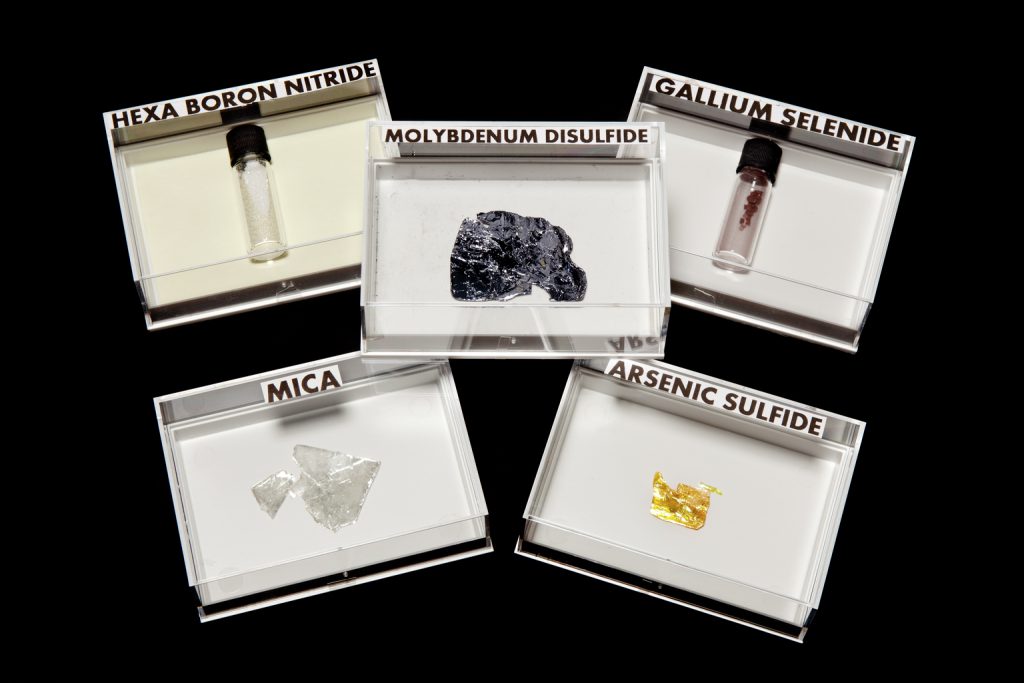
This set of five 2D samples demonstrates that the isolation of graphene in Manchester in 2004 opened the door to a new class of 2D materials. In the Wonder Materials exhibition, they featured in a display in the present-day section of the exhibition about Dr Roman Gorbachev, a scientist based at the University of Manchester working on 2D heterostructures – stacks of single-layer materials with different properties which can be used to create bespoke designer materials for specific purposes. These samples of 2D materials for research were accessioned into the Science Museum Group collection in 2016 from a University of Manchester spin-out company called Manchester Nanomaterials. The samples demonstrate the fact that graphene opened a door to a new area of research and provide a snapshot of the status of 2D materials research just over a decade after the first 2D material, graphene, was isolated. In fact, a lot of the research going on at the NGI today is not directly into graphene, but other 2D materials like these. The research and commercial potential of graphene led to large investment in facilities, such as the National Graphene Institute (NGI) at the University of Manchester.
The Graphene Light Bulb
https://dx.doi.org/10.15180/181004/015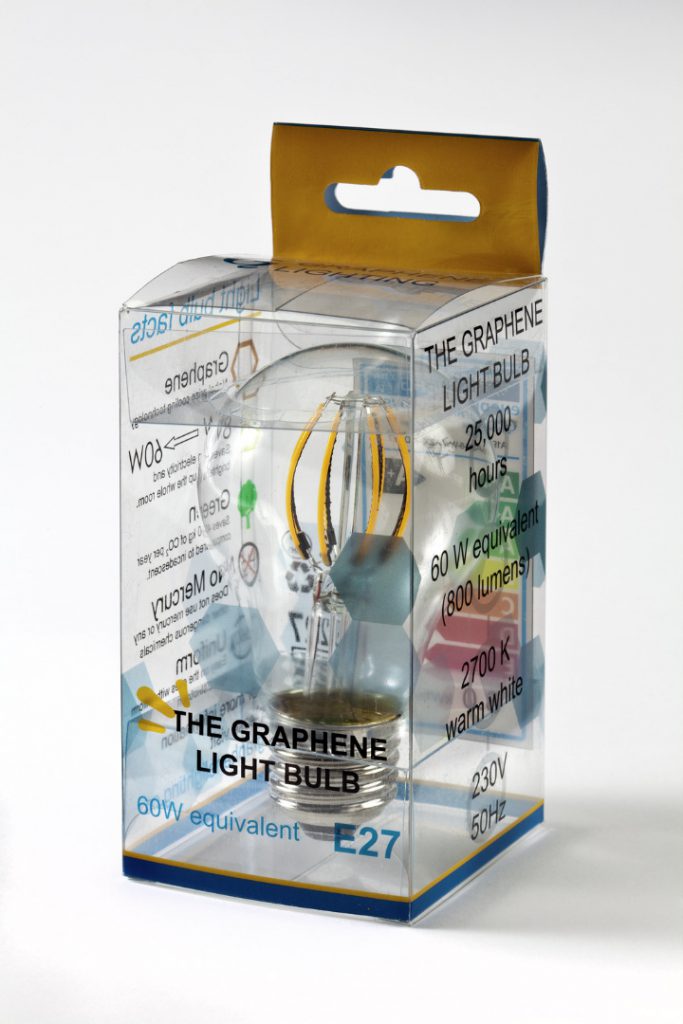
The decision to display commercial products enhanced by graphene exposes a tension in the conceptual strategy adopted by the curatorial team. Initially, the exhibition did not contain commercial products, as the curators were determined not to display ‘yet another object onto which celebratory high-tech fantasy can be projected’ (Barry, 2001: 111). Our approach was rational, analytical, even critical – as discussed earlier we were aiming to portray the field of graphene research as ‘a domain which was still in the making’ (Laurent, in Filippoupoliti, 2010, p 190). However, interim audience research undertaken in April 2017 indicated that visitors were disappointed that they were not able to see graphene products in the exhibition. In response, we added a further two display cases, containing a total of eight products, prototypes and samples of graphene-enhanced products either on sale or in development. We considered displaying the performance equipment such as tennis racquets, skis and fishing rods which were already available in 2016. As discussed in the introduction, we were determined not to add to unrealistic expectations heaped on graphene, however graphene does have great future potential. This luxury sports equipment arguably contained graphene primarily for marketing purposes, and therefore did not resonate with our narrative concept for the Wonder Materials. If we were going to display graphene-enhanced products, it would be those which could have a global impact and/or would be familiar and relatable for all visitors.
The Graphene Light Bulb made by Graphene Lighting plc was the first commercial application of graphene to emerge from the UK. The graphene makes the light bulb work better: this lamp lasts twice as long and uses less energy than a normal LED lamp because the LEDs are coated in graphene to dissipate the heat more efficiently. This object, presented in the exhibition with its plastic box, is an example of a graphene-enhanced item now in mass production, and is available to buy online. Since graphene was isolated, one of the biggest challenges has been finding methods to produce it at high quality on an industrial scale so that it can be used in commercial applications. While the sticky tape method was very useful for researchers in the lab first testing the properties of graphene, it is not suitable for entrepreneurs trying to get their graphene technology onto the production line. This graphene-enhanced light bulb represents the leaps and bounds that have been made in graphene research and production since 2004. A light bulb is a familiar object which museum visitors will recognise, so we included this graphene-enhanced example made by Graphene Lighting plc to help visitors to relate to the environmental impact graphene could have.
As well as displaying The Graphene Light Bulb in the exhibition, the Museum also acquired one for the permanent museum collection. I will now explore in more detail contemporary collecting in the field of science and look at some examples of where contemporary collecting happened before, during and as a legacy of the Wonder Materials exhibition.
Contemporary collecting – benefits, challenges and tactics
https://dx.doi.org/10.15180/181004/016The Museum of Science and Industry collecting policy states an intention to actively collect material that demonstrates the interplay of science, industry and society in Manchester. Based in Manchester and with established networks and contacts across the city including the University of Manchester, the Museum was in an ideal position to undertake contemporary collecting around the origin story of graphene. This material was soon displayed in the Wonder Materials exhibition, demonstrating the advantage of acquiring contemporary science objects responsively. The exhibition was greatly enhanced by inclusion of unique, authentic material. These items, acquired through new contemporary collecting practices, demonstrate the value of the acquisition of material directly from the lead scientists involved in 2006, only two years after their research was published, and four years before their research into graphene was rewarded with the Nobel Prize.
While there are benefits to active contemporary collecting, there are also practical challenges. Many curators do not have time to dedicate to the involved process of contemporary collecting. Contemporary collecting is resource-intensive in terms of staff time, budget, storage and specialist conservation requirements. These considerations need to be built into any project planning. It is also important to establish who in an organisation has responsibility for contemporary collecting.
This paper demonstrates that relationship-building is the cornerstone of good contemporary collecting practice. Tactics for ongoing contemporary collecting include a detailed review of the networks and contacts a museum has access to. Practically speaking, museum curatorial staff cannot have detailed knowledge of the full range and breadth of areas across contemporary science. They do have detailed expertise in reviewing, analysing and selecting material for museum collections. By maintaining a wide and active network, curators can survey a much broader field of interest. External opportunities involve: analysis of key stakeholders to identify existing useful contacts; accessing decision-making contacts via organisation managers, trustees and advisory board and building relationships through the organisation development and fundraising strategies. While it is important to identify who in an organisation is ultimately responsible for contemporary collecting – usually curatorial staff – it is also an advantage to engage with colleagues across a large organisation. General information and ideas can be gleaned from subject-specific mailing lists and monitoring of local news channels and social media. Hidden, surprising stories that might not have a general press release will be more likely to be unearthed through direct contact with people. Other teams in a large organisation can help to maximise contacts. For example, the learning and programming teams within the Science Museum Group – including five national UK museums and forming the largest group of science museums in the world – open opportunities for contemporary collecting through our participatory practice and through our contemporary science programme.
Once material of interest has been identified, the next challenge is to encourage people and companies to donate material to the museum collection. This is easier if they know that there will be a display opportunity, even if this is for a short time only. The Wonder Materials exhibition showcased graphene and made it much easier to have conversations with potential donors about the benefits of donating material. However, even if an exhibition isn’t planned, one tactic to overcome this challenge could be a dedicated space and programme for displaying new acquisitions, such as the Rapid Response (Rapid Response, 2017) collecting at the V&A where recent acquisitions are displayed in a dedicated gallery space: https://www.vam.ac.uk/articles/rapid-response-collecting-an-introduction
Conclusion
https://dx.doi.org/10.15180/181004/017Looking at contemporary collecting around graphene serves as a useful case study for all collecting of contemporary science as it is a particularly fast-moving area identified in the science world and in the media as an area of great interest. There is an imperative for the Museum of Science and Industry to engage in contemporary collecting around graphene, and the benefits and challenges the curatorial team have identified are of relevance for ongoing contemporary collecting strategy and practice.
The Museum has benefitted greatly from working with the scientists involved shortly after the discovery for which they were globally recognised. The relationship developed with the lead scientists and their wider team allowed the Museum to access mundane and surprising personal artefacts, which we know are great for helping visitors engage with personal stories and are very popular with our audiences. This benefit also brings with it the risk of over-closeness to the protagonists of the science story we are telling and their view of events. Immediate contemporary collecting and the display of current personal material does not allow for the increased reflection and critique which inevitably comes with time. On balance, the rare opportunity to engage directly with the key scientists and gain their insight and access to their material culture outweighs any temptation there might be to over-collect to cover all potential future narratives.
Science is a process. Another advantage of collecting contemporary science objects is that the process of collecting, and the objects themselves, support the communication of science as an active process. This narrative of open, live science aligns with the Science Museum Group mission to inspire future generations. The message of Wonder Materials – curiosity, creativity and play in scientific approach – was informed and supported by the review and collecting of material culture undertaken by the curatorial team.
Graphene is a new material. It is exciting because we don’t know exactly where its biggest impact will be. Museums must employ strategies to review and collect the material culture of contemporary science so that collections can be enriched not only with the iconic, presentable remnants traditionally preserved, but the ordinary everyday items which bring the story to life – a battered sticky tape dispenser, perhaps.
Tags
Footnotes
Back to text

